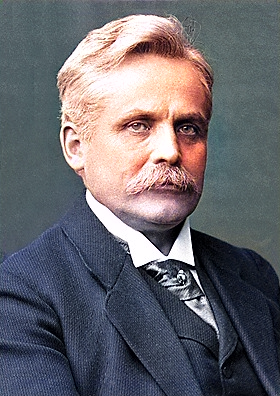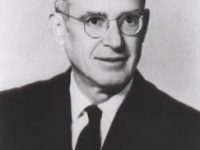
Wilhelm Wien (1864 – 1928)
On January 13, 1864, German physicist Wilhelm „Willy“ Carl Werner Otto Fritz Franz Wien, known as Wilhelm Wien, was born. He primarily researched the laws of thermal radiation and was awarded the Nobel Prize in Physics in 1911 for his work.
Wilhelm Wien – Early Years
Wien was born at Gaffken near Fischhausen, Province of Prussia (now Primorsk, Russia) as the son of landowner Carl Wien. In 1866, the Wien family, including Wilhelm, moved to Drachenstein near Rastenburg, where his father had purchased an estate. Wilhelm attended the Gymnasium in Rastenburg beginning in 1879, but due to poor performance, he had to leave and receive private lessons from the teachers. From 1880 to 1882, he attended the Altstädtisches Gymnasium in Königsberg. From 1882, Wilhelm studied physics at the Georg-August University in Göttingen and the Friedrich-Wilhelms University in Berlin. He worked at the laboratory of Hermann von Helmholtz [1] from 1883 to 1885 and received his doctorate in 1886 with a thesis on the diffraction of light upon metals and on the influence of various materials upon the color of refracted light. He then served as an assistant to von Helmholtz at the Physikalisch-Technische Reichsanstalt from 1889 and habilitated in Berlin in 1892.
Academic Career
In 1896, he became a private lecturer with Adolf Wüllner at the RWTH Aachen. He was appointed to a chair at the Hessian Ludwigs University of Giessen in 1899 and, on February 15, 1900, he succeeded Wilhelm Conrad Röntgen [2] as the head of the Physics Institute at the Julius Maximilian University of Würzburg, where he became friends with Maximilian von Frey. In 1913-1914, Wien served as rector at the University of Würzburg and, as a national-minded professor, supported a Deutschvölkischer Verband founded on July 30, 1919. At the end of 1919, Wien moved to the Ludwig Maximilian University of Munich, again succeeding Röntgen as a university lecturer there in 1920.
Wien’s Displacement Law
In the years of 1893/94, Wien developed his displacement law and from 1894 to 1896, he developed his radiation law to describe the thermal radiation emitted by a blackbody as a function of wavelength. In particular, Wien’s displacement law states that the wavelength at which a blackbody of absolute temperature T emits the most intense radiation is inversely proportional to the temperature. For example, if the temperature of the radiator doubles, the wavelength at which its radiation maximum is located is halved. For example, the glow color of a glowing body changes from initially reddish to whitish to bluish, i.e., to shorter wavelengths, as the temperature increases from 1000 K to 3000 K to 10000 K.
Anode Rays and the Proton
Beginning in 1898, Wien’s work on anode rays established principles of mass spectroscopy and identified a positively charged particle with the mass of the hydrogen atom, known as the proton. Anode rays got their name from the first method of their generation: Ions generated by an electric field in a dilute gas and accelerated toward the cathode, which is provided with holes, pass through these holes (“channels”) due to their inertia and can be detected behind the cathode by their luminous phenomena. This channel-emitting apparatus is also called a Geissler tube. It is an ion source. The anode rays were discovered by Eugen Goldstein in 1886.
The Equivalence of Mass and Energy
In his 1900 paper, Wien, drawing on the work of Heaviside [8] and Searle, argued that all physical processes were electromagnetic in nature and that the mass of a body could be calculated entirely from its electromagnetic energy, which was a significant step towards the equivalence of mass and energy.[8,10] The equivalence of mass and energy, or E = mc² for short, is a law of nature discovered in 1905 by Albert Einstein in the context of special relativity. In today’s formulation, it states that the mass m and the rest energy E0 of an object are proportional to each other.[3]
Ether Theories and Nobel Prize
As a proponent of an electromagnetic worldview, Wien also extensively studied the problems of ether theories of the time and developed differential equations for the electrodynamics of moving bodies in 1904, making him a precursor of the special theory of relativity. In 1911, Wien was awarded the Nobel Prize in Physics for his contributions to the understanding of thermal radiation.
Honors and Later Life
Throughout his career, Wien was active in scientific committees. In 1910, he served as chairman of the Society of German Natural Scientists and Physicians and, in 1920-1922, he was chairman of the German Physical Society. During World War I, he was active in a leading position with other conservative scientists for the interests of the German Reich, particularly pushing back against English influence on German science. However, he later distanced himself from the more radical views of his colleague Philipp Lenard, which led to the propagation of “German physics.” In 1918, he proposed Albert Einstein and Hendrik Antoon Lorentz for the Nobel Prize in Physics.
Wien passed away in 1928 at the age of 64 and was buried in the Munich Waldfriedhof. His cousin, Max Wien, was one of the pioneers of high frequency technology and his son, Karl Wien, became known as an extreme mountaineer.
Selected Publications
- Wilhelm Wien, (1898). . Annalen der Physik. 301 (3): 1–18.
- Wilhelm Wien (1900). Lehrbuch der Hydrodynamik. S. Hirzel.
- Wilhelm Wien (1900). . Annalen der Physik. 310 (7): 501–513.
- Wilhelm Wien (1904a). . Annalen der Physik. 318 (4): 641–662.
- Wilhelm Wien (1904b). . Annalen der Physik. 318 (4): 663–668.
- Wilhelm Wien (1904c). . Annalen der Physik. 319 (8): 635–637.
Wien’s Law Explained – Science With a Lightbulb, [11]
References and Further Reading:
- [1] Hermann von Helmholtz – Physiologist and Physicist, SciHi Blog
- [2] Wilhelm Conrad Röntgen – The Father of Diagnostic Radiology, SciHi Blog
- [3] How Albert Einstein Revolutionized Physics, SciHi Blog
- [4] Rüchardt, E. (1936). “Zur Entdeckung der Kanalstrahlen vor fünfzig Jahren”. Naturwissenschaften. 24 (30): 57–62.
- [5] Rüchardt, E. (1955). “Zur Erinnerung an Wilhelm Wien bei der 25. Wiederkehr seines Todestages”. Naturwissenschaften. 42 (3): 57–62
- [6] Wilhelm Wien on Nobelprize.org including the Nobel Lecture, 11 December 1911 On the Laws of Thermal Radiation
- [7] O’Connor, John J.; Robertson, Edmund F., “Wilhelm Wien”, MacTutor History of Mathematics archive, University of St Andrews
- [8] Oliver Heaviside: XXXIX. On the electromagnetic effects due to the motion of electrification through a dielectric. In: Philosophical Magazine. Band 27, Nr. 167, 1. April 1889
- [9] Oliver Heaviside changed the Face of Telecommunications, SciHi Blog
- [10] G. F. C. Searle M.A: XLII. On the steady motion of an electrified ellipsoid. In: Philosophical Magazine. Band 44, Nr. 269, 1. Oktober 1897
- [11] Wien’s Law Explained – Science With a Lightbulb, Zenergy Films @ youtube
- [12] Timeline of Nobel Laureates in Physics, via Wikidata





